#socio-demographic
Explore tagged Tumblr posts
Text
Prevalence of Hepatitis b and c viral infections among human immunodeficiency virus (HIV) infected patients on highly active anti-retroviral therapy (haart) in the university of port harcourt teaching hospital By Abel Charles In Journal of Clinical Case Reports Medical Images and Health Sciences

ABSTRACT
Introduction: This study determined the prevalence of hepatitis B and C viral infections among human immunodeficiency virus (HIV) infected patients on highly active anti-retroviral therapy (HAART) in the University of Port Harcourt Teaching Hospital.
Methodology: It was a purposive, cross-sectional study that was conducted in the Anti-retroviral clinic of the facility and a sample size of 38.33 (increased to 100, due to perceived small size), using a prevalence of 2.56% from a previous study by Nnakenyi et al. (2019).
Results: There was more female participation, 77.0%, majority had secondary school education, 59.0%, mostly Civil servants, 43.0%, Christians, 87.0% and mainly of Ijaw ethnicity, 39.0%. Majority had heard of HBV and HCV, 84.0%, mainly in the hospital, 36.9%, with the least from friends/family members, 6.0%, 98.0% had not been infected by any of the hepatic viruses, all of them affirmed that the viruses can be treated, 100.0%, while 72.0% confirmed the efficacy of medical treatment for the viruses and 46.0% had been vaccinated against the viruses. Also, majority opined that sexual intercourse is the main route for transmission of the hepatic viruses, 51.0%, followed by blood transfusion, 37.0% and lifestyle is the most common risk factor to contract the viruses, 71.0%. The prevalence of HBV, HCV and VDRL among HIV-infected patients on HAART was 96.0%, 98.0% and 99.0% respectively. Similarly, we observed statistical significance of HBV (0.042) and HCV (0.021), as well as, venereal diseases (0.028).
Conclusion: There is low prevalence of the hepatic viruses among HIV infected persons in the study population, while the existence of a venereal disease is a risk factor to contracting the hepatic viruses, owing to similar pathways of transmission, thus, rigorous efforts at educating the populace about the risk factors and common routes of transmission of these viruses is required.
Keywords: Hepatitis, venereal disease, HIV, HAART, infection.
INTRODUCTION
Human immunodeficiency virus (HIV) is a retrovirus that infects humans and other mammals. Infection by the virus is a huge public health problem, with African being one of the most affected by the pandemic globally resulting in an estimated 25.7 million human infections worldwide (World Health Organization [WHO], 2019).
Viral hepatitis is also a global health challenge of public concern worldwide (Ndifontiayong, Ali, Sokoudjou, Ndimumeh & Tume, 2021). Some of the features associated with the micro-organisms are high prevalence, high mortality and morbidity, poor diagnostic tools, leading to sub-optimal diagnosis and poor management approaches, especially, in developing countries (Naghavi, Wang, Lozano, Davis, Liang, Zhou, Vollset, Ozgoren, Abdalla & Abd-Allah, 2015; Mokdad, Lopez, Shahraz, Lozano, Mokdad, Stanaway, Murray & Naghavi, 2014).
Hepatitis B virus (HBV) alters the liver architecture and may progress to chronic, life-threatening conditions, such as liver cirrhosis and hepatocellular carcinoma or otherwise mild case, known as hepatitis (Nnakenyi, Uchehukwu & Nto-ezimah, 2020). The global prevalence of HBV is estimated as 0.1%-20% (McMahon, 2005; Custer, Sullivan, Hazlet, Lloeje, Veenstra & Kowdley, 2004) and its diagnosis is made by detection from blood and body fluids, such as semen, saliva and nasopharyngeal secretion, while the main routes of transmission are sexual intercourse, mother to child transmission in pregnancy, delivery and breastfeeding, blood contact and sharing of infected materials (WHO, 2011).
In 2017, the World Health Organization (WHO) reported that the global prevalence of hepatitis B surface antigen (HBsAg) in the African region was 60 million, with an estimated prevalence of 6.1% (4.6% - 8.5%) and accounting for an estimated 87,890 annual deaths in sub-Saharan African region alone. Both HIV and HBV infections pose a reciprocal effect on the progression of both diseases in regards to the impact on the morbidity and mortality of the diseases, with co-infection being a serious challenge in resource-constrained settings (Xie, Han, Qiu, Li, Li, Song, Wang, Thio & Li, 2016; Milazzo & Antinori, 2014). In the western countries, complications arising from HBV and HCV and the infections itself are rare, but common in Asia and Africa, where the chronic infection is common and usually acquired through the parenteral route or in adulthood (Lavanchy, 2004).
Hepatitis C virus (HCV) is also a major cause of hepatitis, like HBV, with a chronic potential (Nnakenyi et al., 2020). The transmission of HCV is similar to HBV. There are scanty prevalence data for HCV, especially, in sub-Saharan African region, but approximately 30 million people are reported to be infected by the virus (Matthews, Geretti, Goulder & Klenerman, 2014). HCV also leads to chronic liver diseases like hepatocellular carcinoma, (Ndifontiayong et al., 2021). Both HBV and HCV are very prevalent in patients infected by HIV and those with the disease condition of HIV, AIDS, leading to an increased morbidity and mortality (Spearman, Afihene, Ally, Apica, Awuku & Cunha, 2017). The co-infection of HIV with either HBV, HCV is associated with poor survival, rapid progression to liver diseases and high potential for hepatotoxicity, arising from the anti-retroviral therapy administered (WHO, 2013; Highleyman, 2010).
Globally, an estimated 550 million people are infected by either HBV or HCV, about 9% of the world population, with the former estimated as 350-400 million, while the latter is estimated as 170-180 million (WHO, 2013; Lavanchy, 2011). Also, the three viruses; HIV, HBV and HCV dominant infections in sub-Saharan African, with 2.6 million HBV infections in HIV-infected people and approximately 2.3 million HCV in HIV-infected people (Kourtis, Bulterys, Hu & Jamieson, 2012).
Highly active anti-retroviral therapy, HAART, is a current, commonly implemented regimen for managing HIV infection. It is an innovation in HIV management and effectively reduces the viral load, as well as, increases the CD4 cell count.
Human Immunodeficiency Virus (HIV) infection, in itself, poses enormous burden on the health care system of many countries. However, the condition of infected individuals is worsened in the existence of co-infection, such as the hepatitis virus, causing poor prognosis and potentially shortens life span (Nnakenyi et al., 2020). It rapidly depletes the immune function of the host, as well as, other vital systems of the affected individual. Evidence suggests that HIV infection progresses faster, even to AIDS-defining illnesses, when there is a co-infection with hepatitis viruses (Greub, Ledergerber, Battegay, Grob, Perrin & Furrer, 2000).
Owing to this co-infection, it is advised that when treating HIV patients, their status of HBV and HCV is ascertained, if the patient is actually co-infected by any of the hepatitis viruses. This is important because a report by the WHO global hepatitis strategy for the elimination of viral hepatitis stipulates that by the year 2030, hepatitis disease will assume a huge public health propensity, thus, 80% of individuals eligible for HBV or HCV treatment should be availed the treatment (WHO, 2016). Despite this, in most developing countries, such as Nigeria, the screening for the hepatitis viruses is still a challenge, due to the cost of investigation or vaccination, unlike in HIV (Diwe, Okwara, Enwere, Azike & Nwaimo, 2013).
Prevalence studies abound in Nigeria regarding co-infection of HIV with either hepatitis B or C viruses, employing different settings and population sizes (Hamza et al., 2013; Idoko, Meloni, Muazu, Nimzing, Badung & Hawkins, 2009; Otegbayo, Taiwo, Akingbola, Odaibo, Adedapo & Penugonda, 2008; Ejele, Nwauche & Erhabor, 2004), with diverse but similar results.
In Nigeria, the national guideline for the prevention, treatment and care for HIV-infected patients does not recommend the screening for HBV, but hepatitis B surface antigen, HBsAg, and HCV commonly done as baseline test for the pre-treatment of HIV-infected patients (National Guidelines for HIV Prevention, Treatment and Care, 2016).
In a study conducted in Enugu state, Nigeria, among 1328 HIV-infected patients on HAART, Nnakenyi et al. (2020) reported that the prevalence of hepatitis B virus infection was 7.8%. Another study conducted among 1779 HIV-infected patients in a different geo-political region in Nigeria, reported HBV prevalence of 11.9% (Otegbayo et al., 2008), while other independent, but similar studies employing smaller sample sizes compared to the those earlier described, ranged from 9.7% to 25.0% (Idoko et al., 2009; Uneke, Ogbu, Inyama, Anyanwu, Njoku & Idoko, 2005; Ejele, Nwauche & Erhabor, 2004).
Regarding the co-infection of HIV and HCV, several studies documented distinct findings, majority of which suggest population size and diagnostic equipment and technique plays crucial roles in the prevalence. In some studies conducted in Nigeria, by Nnekanyi et al. (2020), Diwe et al. (2013) and Adewole, Anteyi, Ajuwon, Wada, Elegba and Ahmed (2013), prevalence values of 4.7%, 0.7% and 2.3% respectively were reported respectively.
Similarly, Nnekanyi et al. (2020) and Adewole et al. (2013) reported that HBV is more prevalent and the situation may be similar for other studies both within and outside Nigeria. Observations show that the varying sample sizes of the populations in the respective studies accounted for the differences reported in their prevalence, while positing that although, the three viruses are transmitted through similar routes, their rates of transmission could be dissimilar. For instance, HIV transmission, historically, is most common through the parenteral route, such as multiple blood transfusions and intravenous drug use, in addition to sexual transmission, but the sexual transmission route is less common for HCV (Tedaldi, Hullsiek, Malvestutto, Arduino, Fisher & Gaglio, 2003).
Yet another finding on the co-infection between HIV and either HBV or HCV also reported gender bias against the transmission, especially, HBV. The study reported that HIV/HBV co-infection is more common among men that have sex with men, as against men that have sex with women or women that have sex with women, the transmission being almost inefficient in the latter category, while it is also commoner in heterosexual individuals with multiple sexual partners and contacts with commercial sex workers (Alter, 2006).
Triple infection of the three viruses; HIV, HBV and HCV have been observed in certain circumstances. In three individual groups of study conducted in the southeast, north-central and a sub-urban part of Nigeria by Nnakenyi et al. (2020), Adewole et al. (2009) and Diwe et al. (2013), they reported the prevalence of triple infection as 0.58%, 1.5% and 0% respectively. In response to the varying findings in the respective studies, Nnakenyi and colleagues posited that at this point, it will be difficult to discern if residing in the city poses more risk to contracting triple infection and whether social lifestyle in the urban regions is implicated in the observed prevalence, which is absent in the sub-urban region.
Opaleye, Oluremi, Ogbolu, Babalola, Shittu and Adesiyan (2014) also investigate the prevalence of HBV among HIV-infected patients HAART regimen and reported more male co-infection, while the age group of 30-49 years were more predominantly co-infected.
In a study in Burkina Faso among 11,592 blood donors, with sero-positive HIV blood, 1.13% prevalence of HBV co-morbidity with HIV was reported, while the prevalence of HCV among the HIV sero-positive patients was 0.14% (Tounkara, Sarro, Kristensen, Dao, Diallo & Diarra, 2009). This is a clear contrast from the studies documented from the different geo-political regions in Nigeria and may differ from what is tenable in other climes. A review of comparative studies on the prevalence of HBV among HIV-infected patients in four continents; Asia, Africa, America and Europe, reported higher prevalence of co-infection among patients in the developed continents of America and Europe, as against those in the developing continents of Africa and Asia (Askari, Hakimi, Nasiri, Hassanshahi & Kazemi, 2014). The higher prevalence in the patients of developed continents was attributed to better diagnostic equipment and lower sensitivities available in these continents, as against the developing continents.
The treatment of co-infection with HIV and any of HBV or HCV is another area of interest that have elicited several research discourses. At the moment, HAART is the mainstay for individuals with HIV infection and the combination of HAART regimen for the different co-infection varies. This regimen, HAART, comprises of five main drugs that include; tenofovir, Ribavirin, sofosbuvir and emtricitabine. Studies have reported that in cases of HIV/HBV co-infection, tenofovir and emtricitabine should be employed, since these drugs are effective for the two viruses and reduces the likelihood of HBV developing resistance for any of the drugs, while in co-infection of HIV/HCV, ribavirin and sofosbuvir should be used, just as HBV vaccine can be administered in situations of HIV/HBV co-infection (National Guidelines for Human Immunodeficiency Virus Prevention, Treatment and Care, 2016).
While several studies have been conducted both within and outside Nigeria to ascertain the prevalence of HBV or HCV co-infection among HIV patients on HAART, there is scanty data regarding this in the study area, thus necessitating this study, hoping that it will not only serve as reference, but also avail clinicians and scientists the required information for prompt decisions when attending to these category of patients.
METHODOLOGY
This purposive, cross-sectional study was conducted at the Anti-retroviral clinic and Pathology laboratory of the University of Port Harcourt Teaching Hospital (UPTH), Nigeria, a tertiary healthcare facility located in the southern region of the country and caters for the training of medical students and other allied medical professions, medical and epidemiologic research, as well as, treatment and counseling of medical conditions. A minimum sample size of 38.33 was obtained for the study, using a prevalence of 2.56% (being the average for 4.7%, 0.7% and 2.3% reported for HIV, HBV and HCV respectively) as reported by Nnekanyi et al. (2020), Diwe et al. (2013) and Adewole et al. (2013). However, owing to the small nature of the calculated minimum sample size, it was increased to 100, to make it significant.
5ml venous blood sample was obtained from each participant in the study using an ethylene diamine tetra acetic acid (EDTA) bottle, after they consented to participate and this analyzed by the aid of an auto-analyzer and the result entered into statistical package for social sciences (SPSS) version 22, where both descriptive and inferential analysis were performed. The socio-demographic parameters of the respondents were obtained using a structured questionnaire and also analyzed. Ethical approval for this study was obtained from the Research Ethics Committee of the University of Port Harcourt Teaching Hospital.
RESULTS
This study had more females, 77.0%, they mostly had secondary school education, 59.0%, with the least having primary school education, 18.0%, and were mostly civil servants, 43.0%, while 27.0% were traders and 17.0% were schooling. Also, majority, 87.0% were Christians, but 6.0% were Muslims and they were mostly Ijaws by ethnicity, 39.0%, followed by Igbos, 35.0%, while the least were Hausas, 4.0%.
In table 2 above, it was observed that most of the respondents have heard about the HBV and HCV, 84.0%, with most of them hearing about it in the hospital, 36.9%, followed by school, 32.1%, while the least heard from friends/family members, 6.0%. However, 98.0% had not been infected by any of the hepatic viruses, with all of them affirming that the viruses can be treated, 100.0%, while 68.0% responded that it can affect anybody, while only 1.0% mentioned it can affect children. Similarly, 72.0% of the respondents agreed that the viruses can be treated medically, but 1.0% person mentioned its treatment by fasting/prayer, with less than half, 46.0% taken vaccination against the viruses and those that have not been vaccinated was mostly due to the cost, 88.9%, while the least was due to attitude of health personnel, 1.9%.
The factors that influence the transmission of hepatitis B and C viruses, according to the respondents in this study, is presented in table 3 above. It shows majority of them responding to sex, 51.0%, followed by blood transfusion or blood products, 37.0%, while lifestyle is the most reported risk factor for contracting the viruses, 71.0%, followed by smoking, 13.0%, and the least being canned foods, 1.0%.
DISCUSSIONS
This study recorded more female participation, 77.0%, majority had secondary school education, 59.0%, mostly Civil servants, 43.0%, mostly Christians, 87.0% and mostly Ijaw by ethnic inclination, 39.0%. The finding about more female participation in this study is not surprising, due to the known fact that the female reproductive tract is more receptive and bound to be more impact in infections contracted through sexual intercourse, such as HIV, HBV and HCV. Apart from this, females tend to be more pursuant to seek healthcare than their male counterparts, except the health condition has truly impacted the males, before they reluctantly seek health care. This is in confirmation by the WHO (2019) that women tend to seek help more for their health needs, as well as, being more infected with venereal diseases that are usually, long-standing, owing to the long duration associated with it before clinical symptoms begin to manifest, sometimes, years.
This study also observed that majority of the respondents have heard of HBV and HCV, 84.0%, with many hearing of it in the hospital, 36.9% and the least heard from friends/family members, 6.0%. HIV, like HBV (usually commonly known as hepatitis), are widespread disease conditions, especially, the former, and majority of the populace are aware of it, due to the fact the fact that information about them are ubiquitous. The findings of HIV and HBV in this study are in tandem with those of Ndifontiayong et al. (2021) and Naghavi et al. (2015) respectively. It was also observed in this study that 98.0% of the respondents had not been infected by any of the hepatic viruses, with all of them affirming that the viruses can be treated, 100.0%, with only 1.0% indicating infection in children, while 72.0% confirmed the efficacy of medical treatment for the viruses and 46.0% had been vaccinated against the viruses. This agrees with the report by Highleyman (2010) that although HBV and HCV are in existence and widespread, their prevalence is considerably low in the general population (McMahon, 2005).
We also observed that shows majority of our study participants responded to sexual intercourse being the main route for transmission of the hepatic viruses, 51.0%, followed by blood transfusion or blood products, 37.0% and lifestyle is the most common risk factor for contracting the viruses, 71.0%. The findings of this study disagrees with that of Liaw et al. (2010), which reported that the parenteral route is the most dominant route of transmission of HBV, HCV and HIV globally, especially, through mother to child transmission during delivery and breastfeeding, while other routes, like sexual intercourse, are also common. The prevalence of HBV, HCV and VDRL among HIV-infected patients on HAART in this study was 96.0%, 98.0% and 99.0%. This is an attestation of the finding by McMahon (2005) that the global prevalence of the hepatic viruses was low in the general population. Similarly, we observed statistical significance of HBV (0.042) and HCV (0.021) venereal diseases, such as HIV. This, we believe to be a common trend, since they mostly share common routes of transmission. However, it confirms the reports by Xie et al. (2016), Milazzo and Antinori (2014), and Lavanchy (2004).
CONCLUSIONS
There seems to be low prevalence of the hepatic viruses, even among HIV infected persons in the general population, while the existence of a venereal disease may encourage or serve as risk factor for contracting the hepatic viruses, since they share similar routes of transmission. This, calls for more concerted efforts at educating the populace about the risk factors and common routes of transmission of these viruses.
Conflict of Interest
None.
For more information: https://jmedcasereportsimages.org/about-us/
For more submission : https://jmedcasereportsimages.org/
#Hepatitis#venereal disease#HIV#HAART#infection#Shahraz#Mokdad#HBV#Akingbola#Odaibo#emtricitabine#socio-demographic#Abel Charles#jcrmhs
0 notes
Text
What You Need to Know: Expert Round-Up on the Workforce Landscape in 2025

Table of Contents
Introduction
The Role of Technology in Shaping the Workforce
Employee Experience and Well-Being in 2025
The Impact of Artificial Intelligence on Talent Acquisition
Changing Work Models and Flexibility
Skills Development for the Future Workforce
Conclusion
Introduction
The workforce of 2025 will be shaped by several pivotal factors, including technological advancements, automation, and evolving workplace cultures. According to industry experts, businesses will need to adapt quickly to ensure they stay competitive and align with the needs of a modern workforce. Understanding the workforce landscape in 2025 is critical for organizations seeking to maintain a thriving work environment. In this article, we bring together insights from leaders in HR, technology, and organizational management to provide a comprehensive round-up of strategies for navigating these changes.
1. The Role of Technology in Shaping the Workforce
Technology has been one of the most significant drivers of change in the workforce, and by 2025, its influence will be even more pronounced. From automation to artificial intelligence (AI), technology is revolutionizing how tasks are performed and how employees interact with their roles. Experts emphasize the need for organizations to adopt tools that enhance productivity while also fostering innovation. AI, for instance, can help streamline recruitment processes, but businesses must balance this with the human element to ensure a personalized experience.
2. Employee Experience and Well-Being in 2025
The future of work is not just about what technologies are being used but also how employees feel about their work environment. Employee well-being and engagement will continue to be a top priority for organizations. In 2025, businesses will increasingly focus on creating environments that support both professional and personal growth. Experts predict that offering flexible work arrangements, promoting mental health initiatives, and integrating purpose-driven work will help attract and retain talent in a competitive job market.
3. The Impact of Artificial Intelligence on Talent Acquisition
AI is transforming how organizations recruit and hire talent. By 2025, AI-driven tools will become even more sophisticated in assessing candidate qualifications, matching them to job descriptions, and predicting future performance. However, experts caution that over-reliance on AI for talent acquisition could lead to biases if not properly monitored. The key will be to leverage AI in a way that enhances the recruitment process while maintaining fairness and inclusivity.
4. Changing Work Models and Flexibility
The traditional 9-to-5 work model is rapidly becoming a thing of the past. In 2025, flexible work arrangements, including remote work and hybrid models, will become more widespread. Experts predict that businesses will continue to embrace these models, driven by employee demand for better work-life balance. While some sectors may struggle with this shift, companies that can offer greater flexibility will be in a stronger position to attract top talent.
5. Skills Development for the Future Workforce
As technology continues to advance, there will be a growing need for workers to develop new skills, particularly in areas like data analysis, programming, and digital literacy. By 2025, organizations will need to prioritize ongoing learning and development to ensure their teams stay ahead of the curve. Experts suggest that businesses invest in upskilling programs and create opportunities for employees to grow within their roles. This commitment to skill development will help bridge the talent gap and ensure the workforce remains adaptable to new challenges.
For More Info: https://hrtechcube.com/workforce-landscape-in-2025/
Conclusion
The workforce landscape in 2025 is bound to be marked by significant advancements in technology, shifting work models, and an increased focus on employee well-being. Organizations must be proactive in adopting new technologies while fostering a workplace culture that values flexibility and continuous learning. As the work environment continues to evolve, staying ahead of these trends will be critical for businesses looking to thrive in the future.
By integrating expert advice and adapting to the evolving needs of the workforce, companies can successfully navigate the changes ahead and build a more resilient, productive, and engaged workforce.
#Workforce Landscape#Future of Work#Employee Experience#HR Technology#Workplace Transformation#Artificial Intelligence#Talent Acquisition#Workforce Management#Automation#Human Resources#The workplace landscape is rapidly evolving and is driven by demographic shifts#technological advancements#and socio-economic factors. Looking to the future#industry experts weigh in on how organizations can navigate these changes effectively.
0 notes
Text
Study indicates lower rates of death from Alzheimer's Disease among Taxi and Ambulance Drivers
Study indicates lower rates of death from Alzheimer's Disease among Taxi and Ambulance Drivers @neosciencehub #Sciencenews #healthcare #AlzheimersDisease #neosciencehub #Dementia #featured
According to a recent study, occupations requiring a lot of spatial processing, like navigating to a hospital or figuring out a taxi route, may have a reduced death risk from Alzheimer’s disease. Mass General Brigham researchers looked into this possibility by assessing the likelihood of Alzheimer’s disease death across 443 professions using national data on the occupations of deceased…
#Alzheimer’s disease#cognitive spatial maps#featured#National Vital Statistics System#sciencenews#socio-demographic data
0 notes
Text
Regretfully concluding that "Peter from July Talk is trans" is actually not true, and was just something that I dreamed up.
#it was a detailed dream. there was a moose collision and socio- demographic explanations of Ontario's art scene#the phrase 'ya gotta make BEANS before you can make SOUP' was a metaphor for shitty cover bands
0 notes
Link
1 note
·
View note
Text
Supermarkets really be insulting my intelligence, putting a 'low price!' sticker next to a truly outrageous number. Oh, only $6 for a bag of crisps? What kind of a fool do you think I am?
#oh it used to be $8?#I wasn't born yesterday#I was here when you doubled the price for the pandemic#I REMEMBER#anyway I'm on the low socio-economic demographic diet#it's working out okay#m1ssc0mmun1cates#australia
0 notes
Note
Why do you know brainrot terms? It's scares me
Because the generational divide is an artificial cultural construct used primarily to distract people from Socio-Economic inequality and gatekeeping generational slang that is not tied to a specific sub-demographic only serves to reinforce the distraction. Or to put it another way: Sigmas Eat Werther's Originals whilst listening to Linken park and playing Roblox, no cap.
801 notes
·
View notes
Text

Via NasAlSudan
Learn about the Sudanese revolution, the significance of December 19, and a legacy of resistance and resilience.
Join our call to action today and everyday during Sudan Action Week.
December 19 2023
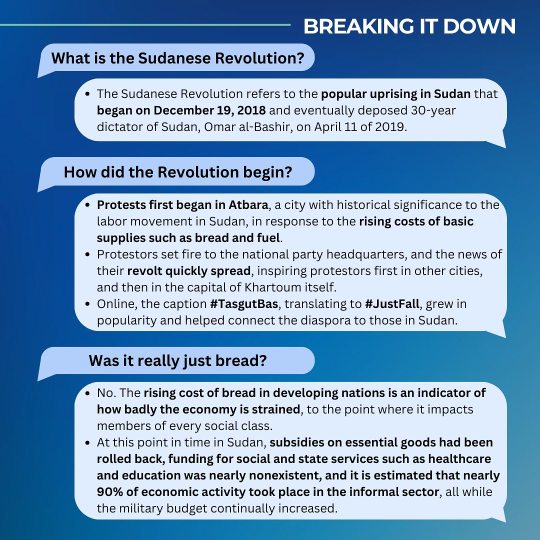
Transcript:
Breaking it down
What is the Sudanese Revolution?
The Sudanese Revolution refers to the popular uprising in Sudan that began on December 19, 2018 and eventually deposed 30-year dictator of Sudan, Omar al-Bashir, on April 11 of 2019.
How did the Revolution begin?
Protests first began in Atbara, a city with historical significance to the labor movement in Sudan, in response to the rising costs of basic supplies such as bread and fuel.
Protestors set fire to the national party headquarters, and the news of their revolt quickly spread, inspiring protestors first in other cities, and then in the capital of Khartoum itself.
Online, the caption #TasgutBas, translating to #JustFall, grew in popularity and helped connect the diaspora to those in Sudan.
Was it really just bread?
No. The rising cost of bread in developing nations is an indicator of how badly the economy is strained, to the point where it impacts members of every social class.
At this point in time in Sudan, subsidies on essential goods had been rolled back, funding for social and state services such as healthcare and education was nearly nonexistent, and it is estimated that nearly 90% of economic activity took place in the informal sector, all while the military budget continually increased.
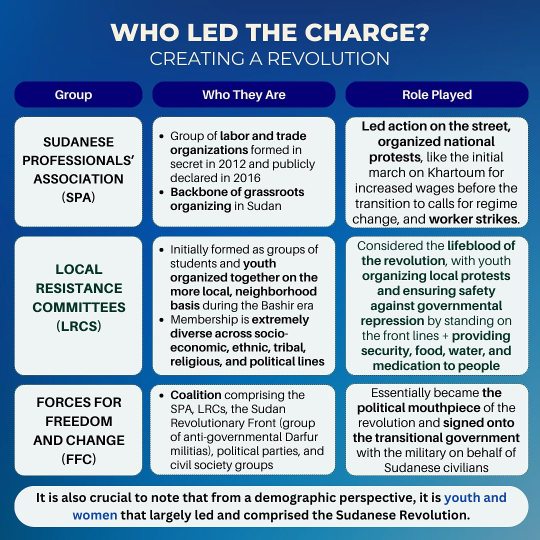
Transcript:
Who led the charge? Creating a revolution
Group: Sudanese Professional's association (SPA)
Who they are:
Group of labor and trade organizations formed in secret in 2012 and publicly declared in 2016
Backbone of grassroots organizing in Sudan
Role played:
Led action on the street, organized national protests, like the initial march on Khartoum for increased wages before the transition to calls for regime change, and worker strikes.
Group: Local Resistance Committees (LRCS)
Who they are:
Initially formed as groups of students and youth organized together on the more local, neighbourhood basis during the Bashir era
Membership is extremely diverse across socio-economic, ethnic, tribal, religious, and political lines
Role played:
Considered the lifeblood of the revolution, with youth organizing local protests and ensuring safety against governmental repression by standing on the front lines + providing security, food, water, and medication to people
Group: Forces for freedom and change (FFC)
Who they are:
Coalition comprising the SPA, LRCS, the Sudan Revolutionary Front (group of anti-governmental Darfur militias), political parties, and civil society groups
Role played:
Essentially became the political mouthpiece of the revolution and signed onto the transitional government with the military on behalf of Sudanese civilians
It is also crucial to note that from a demographic perspective, it is youth and women that largely led and comprised the Sudanese Revolution.
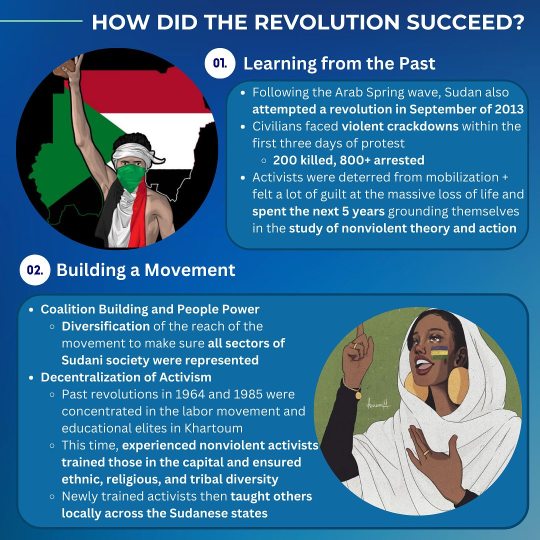
Trabscript:
How did the revolution succeed?
01. Learning from the Past
Following the Arab Spring wave, Sudan also attempted a revolution in September of 2013
Civilians faced violent crackdowns within the first three days of protest. 200 killed, 800+ arrested
Activists were deterred from mobilization + felt a lot of guilt at the massive loss of life and spent the next 5 years grounding themselves in the study of nonviolent theory and action
02. Building a Movement
Coalition Building and People Power
Diversification of the reach of the movement to make sure all sectors of Sudani society were represented
Decentralization of Activism
Past revolutions in 1964 and 1985 were concentrated in the labor movement and educational elites in Khartoum
This time, experienced nonviolent activists trained those in the capital and ensured ethnic, religious, and tribal diversity
Newly trained activists then taught others locally across the Sudanese states
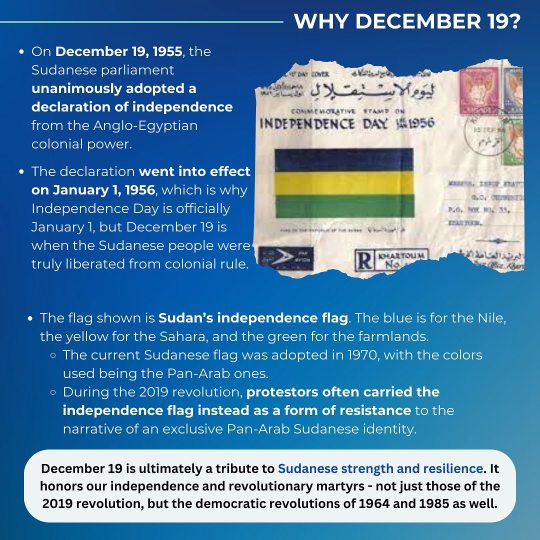
Transcript:
Why december 19?
On December 19, 1955, the Sudanese parliament unanimously adopted a declaration of independence from the Anglo-Egyptian colonial power.
The declaration went into effect on January 1, 1956, which is why Independence Day is officially January 1, but December 19 is when the Sudanese people were truly liberated from colonial rule.
The flag shown is Sudan's independence flag. The blue is for the Nile, the yellow for the Sahara, and the green for the farmlands.
The current Sudanese flag was adopted in 1970, with the colors used being the Pan-Arab ones.
During the 2019 revolution, protestors often carried the independence flag instead as a form of resistance to the narrative of an exclusive Pan-Arab Sudanese identity.
December 19 is ultimately a tribute to Sudanese strength and resilience. It honors our independence and revolutionary martyrs - not just those of the 2019 revolution, but the democratic revolutions of 1964 and 1985 as well.

Transcript:
Why is the revolution ongoing?
The goal was never just the fall of a dictator. The goal was, and is, to build a better Sudan, one free from military rule. One with equal opportunities for everyone, with economic prosperity and safety and security - the key principles of freedom, peace, and justice that the revolution called for.
Today, though, before we rebuild Sudan, before we free it from foreign interests and military rule and sectarianism, we need to save it. Each day that passes by with war waging on is one where more civilians are killed. More people are displaced. More women are raped. More children go hungry. To live in the conflict zones in Sudan right now - whether that be Khartoum, Darfur, Kordofan, or now, Al Gezira, is to be trapped in a never-ending nightmare, a fight for survival. And to live elsewhere in Sudan is to wonder whether you're next.
Sudan Action Week calls on you to educate yourself and others about Sudan, and then to help the Sudanese people save it, because we can no longer do it alone.
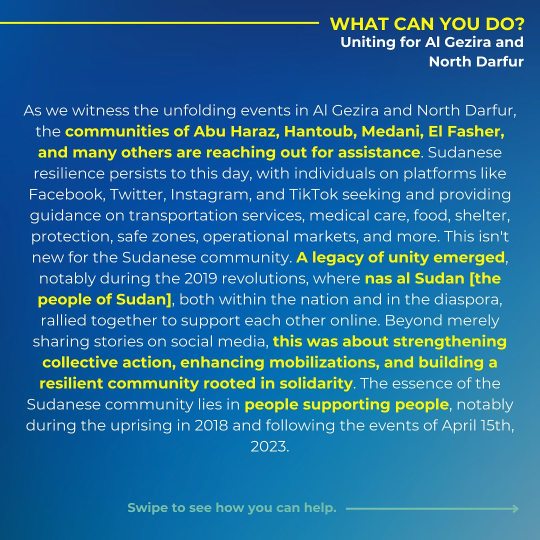
Transcript:
What can you do? Uniting for Al Gezira and North Darfur
As we witness the unfolding events in Al Gezira and North Darfur, the communities of Abu Haraz, Hantoub, Medani, El Fasher, and many others are reaching out for assistance. Sudanese resilience persists to this day, with individuals on platforms like Facebook, Twitter, Instagram, and TikTok seeking and providing guidance on transportation services, medical care, food, shelter, protection, safe zones, operational markets, and more. This isn't new for the Sudanese community. A legacy of unity emerged, notably during the 2019 revolutions, where nas al Sudan [the people of Sudan], both within the nation and in the diaspora, rallied together to support each other online. Beyond merely sharing stories on social media, this was about strengthening collective action, enhancing mobilizations, and building a resilient community rooted in solidarity. The essence of the Sudanese community lies in people supporting people, notably during the uprising in 2018 and following the events of April 15th, 2023
Swipe to see how you can help.
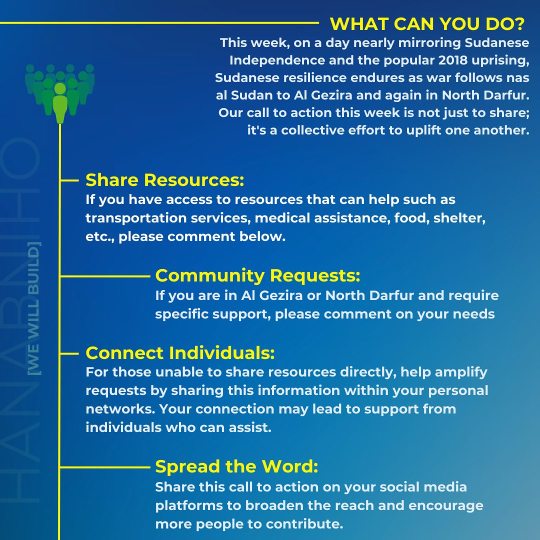
Transcript:
What can you do?
This week, on a day nearly mirroring Sudanese Independence and the popular 2018 uprising, Sudanese resilience endures as war follows nas al Sudan to Al Gezira and again in North Darfur. Our call to action this week is not just to share; it's a collective effort to uplift one another.
Share Resources:
If you have access to resources that can help such as transportation services, medical assistance, food, shelter, etc., please comment below.
Community Requests:
If you are in Al Gezira or North Darfur and require specific support, please comment on your needs
Connect Individuals:
For those unable to share resources directly, help amplify requests by sharing this information within your personal networks. Your connection may lead to support from individuals who can assist.
Spread the Word:
Share this call to action on your social media platforms to broaden the reach and encourage more people to contribute.

Transcript:
Hanabniho
حنبنيهوا
[We will rebuild]
#keepEyesOnSudan
#SudanActionWeek
924 notes
·
View notes
Text
Under the six-week ban, providers could not perform abortions if they detected fetal cardiac activity, which emerges at about six weeks into pregnancy. Many women, McBurney wrote, do not even know they are pregnant at six weeks.
“For these women, the liberty of privacy means that they alone should choose whether they serve as human incubators for the five months leading up to viability,” McBurney wrote. “It is not for a legislator, a judge, or a commander from The Handmaid’s Tale to tell these women what to do with their bodies during this period when the fetus cannot survive outside the womb any more so than society could – or should – force them to serve as a human tissue bank or to give up a kidney for the benefit of another.”
In a footnote, McBurney added: “There is an uncomfortable and usually unspoken subtext of involuntary servitude swirling about this debate, symbolically illustrated by the composition of the legal teams in this case. It is generally men who promote and defend laws like the Life Act, the effect of which is to require only women – and, given the socio-economic and demographic evidence presented at trial, primarily poor women, which means in Georgia primarily black and brown women – to engage in compulsory labor, ie, the carrying of a pregnancy to term at the government’s behest.”
#us politics#reproductive rights#georgia#the ag there can (lbr he will) appeal the case to the state supreme court#and the state supreme court can (lbr they will) reinstate the 6 week ban
237 notes
·
View notes
Text

Why Non-Black People Fear Black Self-Help—and Why Black People Shouldn’t Care (A Garveyite Perspective)
From a Garveyite lens, rooted in the teachings of Marcus Garvey and Pan-Africanism, Black self-determination is not just a goal—it’s a necessity. Yet, throughout history, efforts by Black people to uplift and empower themselves have often been met with resistance, fear, and concern from non-Black groups. Why is this the case? And why, according to Garveyite philosophy, should Black people not concern themselves with these reactions?
Let’s break it down by demographic and dive into the root of these issues.
White People: Fear of Losing Power
Why They Fear Black Self-Help
1. Economic Dependency
The transatlantic slave trade, Jim Crow laws, and even modern capitalism have relied on Black labour and consumption to sustain white wealth. Black self-reliance disrupts these economic structures.
2. Challenge to White Supremacy
White supremacy thrives on the narrative of Black inferiority. When Black people organize and thrive independently, it threatens the foundation of this ideology.
3. Fear of Retaliation
Centuries of systemic oppression create a lingering fear that an empowered Black population may seek revenge or disrupt white-dominated institutions.
4. Guilt and Accountability
Black self-help forces white people to confront their role in historic and systemic oppression, creating discomfort and resistance.
Garveyite Response
Marcus Garvey famously said, “The Negro must be self-reliant.” White feelings are irrelevant when the goal is freedom. Black people cannot wait for white approval to act in their own best interests.
Asian Communities: Fear of Economic Disruption
Why They Fear Black Self-Help
1. Economic Competition
Many Asian immigrant businesses (e.g, Inidan/ Korean-owned beauty supply stores) profit from Black neighborhoods without reinvesting in them. Black-owned businesses threaten this status quo.
2. The "Model Minority" Myth
Anti-Blackness is baked into the "model minority" narrative, which positions Asians as "successful" by proximity to whiteness. Black empowerment disrupts this racial hierarchy.
3. Cultural Distance
Due to historical anti-Black stereotypes and a lack of solidarity, some Asian communities may view Black independence with scepticism or fear.
Garveyite Response
Garvey taught that “no one knows when the hour of Africa’s redemption cometh.” Black people must focus on rebuilding their communities without worrying about disrupting anyone else’s economic or cultural comfort.
Hispanic/Latino Communities: Fear of Marginalization
Why They Fear Black Self-Help
1. Resource Competition
Hispanic/Latino and Black communities often occupy the same socio-economic space. Black self-help is seen as competing for limited resources like housing, jobs, or political influence.
2. Internalized Anti-Blackness
Colonial histories of colourism and caste systems perpetuate anti-Black sentiment within Latino cultures, leading to mistrust of Black movements.
3. Political Power Dynamics
As Latino populations grow, there’s a fear that Black empowerment movements might outpace their own political or social progress.
Garveyite Response
Black people’s struggles and liberation are unique and cannot be conflated with others’. The focus must remain on the upliftment of the Black race without being derailed by concerns over perceived competition.
Arab and Middle Eastern Communities: Fear of Losing Economic Footing
Why They Fear Black Self-Help
1. Economic Dependence on Black Communities
Arab-owned corner stores and gas stations often dominate Black neighbourhoods. Black-owned businesses threaten this dynamic.
2. Anti-Black Cultural Attitudes
Some Arab cultures perpetuate anti-Blackness, often rooted in histories of the trans-Saharan slave trade and colonial racism. Black empowerment challenges these biases.
Garveyite Response
Garvey’s teachings remind us that no group has the right to profit off Black labour and communities without reciprocation. Black people must reclaim ownership of their economies, regardless of the discomfort it causes others.
Other oppressed Communities: Tensions Over Shared Struggles
Why They Fear Black Self-Help
1. Competing Oppression Narratives
Black and other oppressed people have faced colonial oppression, but there’s a fear that Black self-help movements might overshadow these oppressed people's struggles.
Garveyite Response
While solidarity with other oppressed groups is important, Garveyite philosophy emphasizes that Black liberation must come first. Black people can not carry the weight of others’ struggles while fighting their own.
The Bigger Picture: Why These Fears Exist
Across all demographics, the resistance to Black self-help stems from:
Economic Dependency: Many groups rely on Black labour and consumption.
White Supremacy: Anti-Blackness is a unifying force in global racial hierarchies.
Fear of Change: An empowered Black population threatens existing systems of privilege and oppression.
Why Black People Shouldn’t Care
1. Liberation Is Non-Negotiable
Garvey said it best: “Up, you mighty race, accomplish what you will.” Black liberation can not be compromised to appease the fears or discomfort of others.
2. Others Have Always Prioritized Themselves
No other group pauses their progress to accommodate Black people. It’s time for Black communities to unapologetically focus on themselves.
3. Historical Proof of Success
Movements like the UNIA, Black Wall Street, and Pan-Africanism have shown that Black self-reliance works—despite resistance from others.
4. White Supremacy Is the Root Cause
Many of these fears are rooted in white supremacy, which pits marginalized groups against one another. Black people must dismantle this system by prioritizing their own empowerment.
5. Self-Determination Is a Human Right
Every group has the right to organize for its own survival and success. Black people are no exception.
Conclusion
Black self-help and self-determination will always provoke fear and resistance from those who benefit from the current power dynamics. From a Garveyite perspective, these concerns are irrelevant. Black people must prioritize their own liberation, unity, and empowerment without apology.
As Garvey proclaimed, “Africa for the Africans, at home and abroad.” Let the discomfort of others be a testament to the power of Black progress. Stay focused, stay unified, and keep moving forward.
#black people#black history#black#black tumblr#blacktumblr#pan africanism#black conscious#africa#self empowerment#self determination#marcus garvey#black power#black empowering#black liberation#racial justice#people of color
85 notes
·
View notes
Text
gotta put my thoughts down before i forget it but the thing that did it in for me is how spy x family is ultimately and uniquely a “children-focused” work, where the major stakes require that we pay attention to the lives and dynamics of young children so that — specifically — we have to genuinely engage with and invested in their inner lives, motivations, desires, thoughts, emotions, etc.
i think this is a very unique focus in the shounen sphere, where the audience and creators are centered about adolescent boys (the shounen genre, in its name) and thus have a very wide scope of focus that nonetheless has “aged” past “childhood”. usually media about children and childhood are sequestered in its own genre (children’s shows like doraemon, magical girl anime like precure series, etc.) aimed at a different target audience who are in the same demographic as the main characters in the shows. this is, obviously, not a bad thing. but i appreciate the “genre-breaking” focus that spy x family have because it inspires a sort of empathy to children, who are often not the most favorite group of people for the typical demographic of shounen readers, that is specifically vital in today’s climate. (can’t say much about japan itself, who historically has been dealing with declining birth rates, but oh i can speak for the american individualism— ironically where sxf is also very popular in) another thing about this is it’s drive home how intertwined the family life is, and should be. agent twilight and thorn princess’s plot-lines are clearly shounen-esque (a spy fighting for world peace, an assassin weeding out traitors) but they are nonetheless inextricable from the family- and anya-focused story, because by choice or circumstances they are anya’s parents. they’re a part of a larger societal fabric that embedded them in relationships to others — children being one of them. i think that’s pretty neat.
another thing, specially about the depiction of children in sxf: they are fictitious yet realistic enough to portray real children and inspire sympathy for them. a lot of asian home media in general have the problems of portraying young children as “problems”: annoying, loud, privileged, dumb, ungrateful, etc etc. these are such complaints about children that are unfortunately way too common and way too ungenerous and mean-spirited; none of these tropes are present, even in a media full of scions and heiress. complaints about them being brats (red circus bus hijacking arc) was rightfully framed as unsympathetic and unreasonable (they’re children! they can’t help where they were born into— it goes both ways.) i think the crux of this beautiful balance sxf struck in portraying nuanced, dynamics children is sympathy. they can be loud, they can be whiny, cry at the drop of a hat, has too much energy, gross, have bad grades, clingy, inconsistent, academically unmotivated, ran off randomly— and that’s fine, because we know why they do it, we are given space into their inner thoughts, something so rarely afforded to real life children at times. but they can be motivated, they want world peace, they want to have genuine friends, they want their friends to be happy, they have crushes, and most of all they love their parents and they love the people around them.
i think regardless of everything sxf is a work that understands that children are full of love and the majority of the things they do are out of love. i think that alone makes it incredible in the current socio-econo-political climate where sympathy is spared so little and humanity spreads so thin children barely gets what they deserve. i suppose that’s the sort of war we are entrenched in.
#spy x family#spy x family meta#i guess?#it’s late and i have been rereading spy x family obsessively to cope and i just#have a lot of feelings about it#anya forger#damian desmond#becky blackbell#damian’s friends too but i don’t know their full names. sorry kids.#all of these children are so precious and i would die and kill for them and would live to build world peace for them. if you catch my drift
241 notes
·
View notes
Text
Common Symptoms Were Fatigue and Decreased Exercise Tolerance, According to a 2022 Survey
Inequities In the Prevalence and Severity of Symptoms Observed Across Race, Ethnicity, Gender, and Neighborhood Poverty
December 26, 2024 — Today, the New York City Health Department announced that 80 percent of adult New Yorkers infected with COVID-19 who were surveyed experienced at least one symptom lasting one month or longer. According to the results of the COVID-19 Experiences Survey in 2022, the most common symptoms were fatigue and decreased exercise tolerance. While post-acute symptoms may resolve within 12 weeks, many people will go on to develop Long COVID, an infection-associated chronic condition characterized by symptoms lasting three months or longer.
“This survey shows us that the symptoms following COVID-19 infections are a significant public health issue for New Yorkers. Black and Latino communities, women, transgender people, and those living in low-income neighborhoods were more likely to have symptoms, highlighting the disproportionate impact of the pandemic on marginalized communities,” said Acting Health Commissioner Dr. Michelle Morse. “We must invest in a comprehensive long-term response to the COVID-19 pandemic that focuses on prevention through engagement with health care providers and community members. Services for people experiencing the long-term physical, mental, social, and economic impacts of COVID-19 infection should be accessible to all.”
Post-acute symptoms are those that last one month or longer. To better understand experiences of COVID-19 post-acute symptoms, the Health Department conducted the COVID-19 Experiences Survey in November and December 2022. Adult New Yorkers who were members of the probability-based NYC Health Panel were invited to take the survey if they had confirmed or suspected COVID-19; 2,081 people completed the survey online or by phone in English, Spanish, Russian, Simplified Chinese, or Traditional Chinese. The results provide insight into how post-acute symptoms relate to health care seeking, social and demographic factors, disability, and mental health.
Some respondents reported many symptoms at different levels of severity, while others reported few symptoms, only mild symptoms, or none at all. Inequities in the prevalence and severity of post-acute symptoms after COVID-19 were observed across race/ethnicity, gender, and neighborhood poverty levels.
The prevalence of mild symptoms was similar across socio-demographic groups.
Moderate symptoms were more prevalent among Latino and Asian/Pacific Islander adults compared with white adults, and among people living in high poverty neighborhoods compared with people in low poverty neighborhoods.
Severe symptoms were more prevalent among women and transgender or non-binary adults compared with men, among Latino and Black adults compared with white adults, and among people living in very high and high poverty neighborhoods compared with low poverty neighborhoods.
Increasing symptom severity was associated with activity limitations and depression. Those with at least one severe symptom were more likely to report activity limitations compared with those who reported no post-acute symptoms (60 percent vs. 6 percent), which may result in social, economic, and mental health difficulties.
People with at least one severe post-acute symptom reported 10 days of reduced ability or complete inability to carry out usual activities or work in the past month, compared with 6 days for moderate symptoms, 3 days for mild symptoms, and 1 day for no symptoms.
One in three adults (33 percent) with at least one severe post-acute symptom after COVID-19 had probable depression, higher than those reporting only mild symptoms (6 percent) or no symptoms (2 percent).
Black and Latino New Yorkers, women, transgender adults, and those living in low-income neighborhoods were most likely to report severe symptoms, reflecting the disproportionate impact of the ongoing pandemic in these communities.
To address inequities in awareness about the long-term health impacts of COVID-19 and the importance of preventing new infections, the NYC Health Department partners with community and faith-based organizations to serve as trusted messengers and provide tailored and culturally resonant public health outreach to NYC communities.
Anyone can become very sick from COVID-19. To find a COVID-19 or flu vaccination site, visit nyc.gov/vaccinefinder or call 212-COVID-19 (212-268-4319).
#031-24
MEDIA CONTACT: Chantal Gomez [email protected]
Gomez, Chantal. “Health Department Finds Most Adult New Yorkers Infected with COVID-19 Experienced Symptoms Lasting One Month or Longer.” Health Dept. Finds Most Adult NYers Infected With COVID-19 Experienced Symptoms Lasting 1 Mo or Longer - NYC Health, NYC Health, 26 Dec. 2024, www.nyc.gov/site/doh/about/press/pr2024/nyc-adults-with-covid-19-experienced-symptoms-one-month-or-longer.page.
I’d like to highlight that date: December 26, 2024.
#op#links#usa#nyc#public health#covid#long covid#covid-19#sars-cov-2#sars cov 2#covid19#covid 19#long covid awareness#covid isn't over#still coviding#covid conscious#pandemic#coronavirus#covid pandemic#coronavirus pandemic#infectious disease#infectious diseases#disability#chronic illness#post-acute covid-19#covid cautious
50 notes
·
View notes
Photo

The Politics of Reproduction in Ottoman Society, 1838-1900
"The Politics of Reproduction in Ottoman Society, 1838-1900" sheds light on how turbulent population changes led to anxieties in the Ottoman elites and the state. In this context, Balsoy illustrates how medical modernization was employed by authorities to discipline the female body and control the population. The book provides a clear image of the 19th Century’s perspective on women in Ottoman society and is a must-read for those interested in Ottoman women's history.
Gülhan Balsoy is a professor of history at Istanbul Bilgi University. The book is a revised and rewritten version of Balsoy’s PhD thesis. The book's five chapters respectively focus on the history and transformation of midwifery, abortion, pregnancy, and infertility in Ottoman society. While investigating these themes, Balsoy asserts that reproduction was not a natural experience but a political subject. Balsoy examines how the Ottoman state and elites attempted to change together with control of the female body and subjected it to medical and legal control by using institutions, laws, and medical doctors. According to Balsoy, the state and Ottoman elites constructed the pronatalist means to increase the Turkish/Muslim population by transforming midwifery practices, banning abortion, medicalizing pregnancy/childbirth, and inclining on infertility issues. Balsoy challenges the dominant idea in the historical scholarship that the Ottomans attempted to create a heterogenous Ottoman identity in the society.
The main contribution of this book is derived from the reception of medical modernization through political and institutional means. It demonstrates that the medical elites or obstetricians reflected the Ottoman state’s mentality on the decline of the Turkish/Muslim population. For example, the first law on abortion in 1838, the establishment of the Midwifery School in 1842, and licensing midwives or prioritizing obstetricians were precautions for the state’s population anxiety. However, after investigating literature on Besim Ömer, a famous pronatalist, and Ottoman obstetrician at that time, Balsoy successfully showed that the dichotomy between “old crones” and doctors were not the whole picture. Besim Ömer and many obstetricians asserted that "old crones" were uneducated and lacked hygiene. Despite their ideas about untrained midwives, doctors or licensed midwives also experienced failures in their operations. Thus, the problem put forward by Besim Ömer was not demographic but political and ideological. Another impactful aspect of the book is how anti-abortion and pronatalist ideas are represented in popular literature and advice books for pregnant women. These sources help us to map a combination of social mentality and forced pronatalist agenda by Ottoman authorities, which controlled and disciplined female bodily experiences to alleviate the population anxieties of the elites.
Despite these contributions, there lacks an explanation of how and why these elites had population anxiety or whether they were sure about their homogeneous Ottoman identity in every case. In other words, did all Ottoman elites have this population anxiety? Many sources utilized by Balsoy usually only show us the perception of the Ottoman obstetricians. Another point raised is the comparison between other social groups. For example, the practices of non-Muslim women, especially midwifery or the medicalization process of pregnancy and their experiences, are lacking. However, including other socio-ethnic and religious groups may enrich the literature on the effects of reproduction policies. It is understandable that this book lacks in these two points since finding primary sources written by women and other disenfranchised groups in Ottoman society has always been a challenge for historical scholarship.
This book is an academically fulfilling work on the late Ottoman society. Specifically, prescriptive or advice books and popular literature are utilized quite well in this book. However, her main argument about the politicization of reproduction and the female body stays slightly rigid because the primary Ottoman sources give us a more sophisticated picture than Balsoy's main argument. The spread of pronatalist ideas and politicization of the female body via medicalization and legal means can provide a portrait of how the state and the elites may have population anxieties. Nevertheless, we still cannot avoid the complexities of social changes in the public area, especially when there are few personal or collective accounts of women. In the end, Balsoy's argument is well-researched and invaluable for opening up a space for discussing the female experiences in the late period of Ottoman society.
Continue reading...
42 notes
·
View notes
Text
The analysis found that although the proportion of medical students from the lowest socio-economic backgrounds had doubled since 2012, they made up only 5% of entrants in 2021.
In comparison, 75% of medical school entrants were from a higher socio-economic background. Socio-economic status was calculated by using the five-level National Statistics Socio-economic Classification (NS-SEC) groupings of parental occupation.
Applicants from independent schools across the UK were 1.5 times more likely to receive an offer from a medical school compared with students from non-selective state schools and, even after adjusting statistically for their exam grades, socio-economic status and other demographic factors, independent school applications were still more likely to receive an offer.
12 notes
·
View notes
Text
Carter Sherman at The Guardian:
A Georgia judge on Monday struck down the state’s six-week abortion ban, ruling that the ban is unconstitutional and blocking it from being enforced. In a 26-page opinion, the Fulton county superior judge Robert McBurney ruled that the state’s abortion laws must revert to what they were before the six-week ban – known as the Life Act – was passed in 2019. The ban was blocked as long as Roe v Wade was the law of the land, but went into effect after the US supreme court overturned Roe in 2022. “When a fetus growing inside a woman reaches viability, when society can assume care and responsibility for that separate life, then – and only then – may society intervene,” McBurney wrote. Abortions are now legal in Georgia up until about 22 weeks of pregnancy – the point at which Georgia permitted abortions prior to the Life Act. However, fetal viability tends to occur closer to 24 weeks of pregnancy. Although the Roe line of jurisprudence was supposed to prevent states from banning abortion prior to fetal viability, Georgia and several other states did so anyway even before Roe fell.
Under the six-week ban, providers could not perform abortions if they detected fetal cardiac activity, which emerges at about six weeks into pregnancy. Many women, McBurney wrote, do not even know they are pregnant at six weeks. “For these women, the liberty of privacy means that they alone should choose whether they serve as human incubators for the five months leading up to viability,” McBurney wrote. “It is not for a legislator, a judge, or a commander from The Handmaid’s Tale to tell these women what to do with their bodies during this period when the fetus cannot survive outside the womb any more so than society could – or should – force them to serve as a human tissue bank or to give up a kidney for the benefit of another.” In a footnote, McBurney added: “There is an uncomfortable and usually unspoken subtext of involuntary servitude swirling about this debate, symbolically illustrated by the composition of the legal teams in this case. It is generally men who promote and defend laws like the Life Act, the effect of which is to require only women – and, given the socio-economic and demographic evidence presented at trial, primarily poor women, which means in Georgia primarily black and brown women – to engage in compulsory labor, ie, the carrying of a pregnancy to term at the government’s behest.”
Fulton County Justice Robert McBurney issues a ruling in Sistersong v. Georgia that HB481 be struck down, reverting the state’s abortion laws to pre-HB481 times, in which abortion is permitted up to 22 weeks.
HB481 was passed in 2019 and took effect in 2022 after Dobbs was handed down that bans abortions in Georgia after 6 weeks.
#Georgia HB481#Georgia#Abortion Bans#Abortion#Fetal Viability#Sistersong v. Georgia#Robert McBurney#Reproductive Health
18 notes
·
View notes
Link
1 note
·
View note